Related Research Articles

Mir Qamar-ud-din Khan Siddiqi also known as Chin Qilich Qamaruddin Khan, Nizam-ul-Mulk, Asaf Jah and Nizam I, was the first Nizam of Hyderabad. He was married to the daughter of a Syed nobleman of Gulbarga. He began his career as a favourite of the Mughal emperor Aurangzeb, who made him a general. Following the death of Aurangzeb in 1707, Asaf Jah refused to favour any one of Aurangzeb's warring sons and as such remained neutral. When Aurangzeb's third son Bahadur Shah ultimately emerged victorious, Asaf Jah was rotated as governor of multiple Mughal provinces until 1714, when he was created Viceroy of the Deccan with authority over six Mughal provinces in southern India from 1714 to 1719. From 1719 onwards he was involved in combating the intrigues of the Sayyid Brothers. From 1720 to 1722 he helped the new Mughal emperor Muhammad Shah eliminate the Sayyed brothers and was rewarded by being elevated to the grand viziership from 1722 to 1724. He also engaged in military conflict against Bajirao I in Battle of Palkhed and Battle of Bhopal.
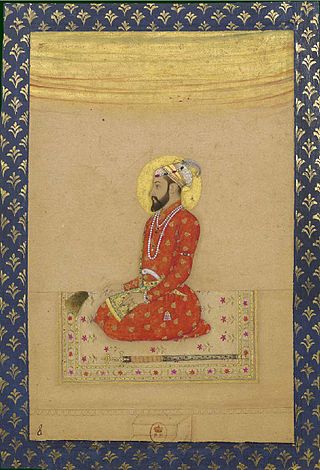
Mirza Muhammad Mu'azzam, commonly known as Bahadur Shah I and Shah Alam I, was the eighth Mughal Emperor from 1707 to 1712. He was the second son of the sixth Mughal Emperor Aurangzeb, who he conspired to overthrow in his youth. He was also governor of the imperial provinces of Agra, Kabul and Lahore and had to face revolts of Rajputs and Sikhs.

Mirza Abu'l Fayaz Qutb-ud-Din Mohammad Azam, commonly known as Azam Shah, was briefly the seventh Mughal emperor from 14 March to 20 June 1707. He was the third son of the sixth Mughal emperor Aurangzeb and his chief consort Dilras Banu Begum.

The Deccan Sultanates were five late-medieval Indian kingdoms—on the Deccan Plateau between the Krishna River and the Vindhya Range—that were ruled by Muslim dynasties: namely Ahmadnagar, Berar, Bidar, Bijapur, and Golconda. The sultanates had become independent during the break-up of the Bahmani Sultanate. The five sultanates owed their existence to the declaration of independence of Ahmadnagar in 1490, followed by Bijapur and Berar in the same year. Golconda became independent in 1518, and Bidar in 1528.

Nizam of Hyderabad was the title of the ruler of Hyderabad State. Nizam is a shortened form of Niẓām ul-Mulk, which means Administrator of the Realm, and was the title bestowed upon Asaf Jah I when he was appointed Viceroy of the Deccan by the Mughal Emperor Farrukhsiyar. In addition to being the Mughal Viceroy (Naib) of the Deccan, Asaf Jah I was also the premier courtier of the Mughal Empire until 1724, when he established the independent monarchy of Hyderabad and adopted the title "Nizam of Hyderabad".

The Qutb Shahi dynasty was a Persianate Shia Islamic dynasty of Turkoman origin that ruled the Sultanate of Golkonda in southern India. After the collapse of the Bahmani Sultanate, the Qutb Shahi dynasty was established in 1512 AD by Sultan-Quli Qutb-ul-Mulk, better known though less correctly referred to in English as "Quli Qutb Shah".
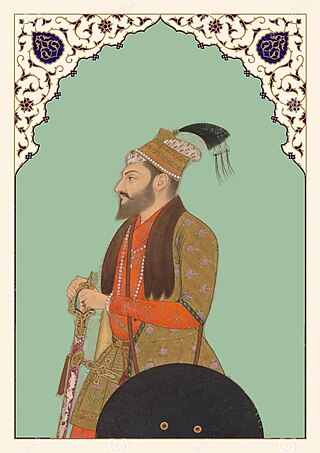
Mirza Muhammad Murad Bakhsh (9 October 1624 – 14 December 1661) was a Mughal prince and the youngest surviving son of Mughal Emperor Shah Jahan and Empress Mumtaz Mahal. He was the Subahdar of Balkh, till he was replaced by his elder brother Aurangzeb in the year 1647.
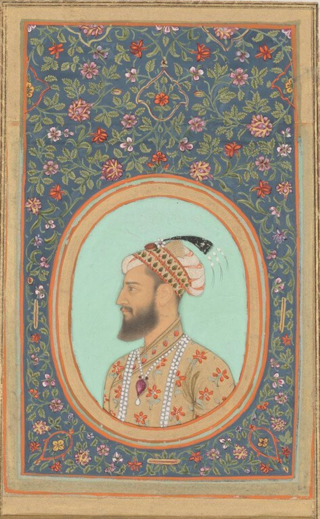
Mirza Muhammad Kam Bakhsh was the youngest son of Mughal emperor Aurangzeb, born to his wife Udaipuri Mahal.

Muhammad Ismail, known by his title Zulfiqar Khan, was a leading noble and military general of the Mughal Empire. His father was Asad Khan, wazir to Mughal emperor Aurangzeb. During Aurangzeb's reign, Zulfiqar Khan led several military campaigns in pursuit of the emperor's ambitions in the Deccan and South India, notable of which is the Siege of Jinji. He held the post of mir bakhshi, appointed towards the later part of Aurangzeb's reign, and was made governor of the Deccan by emperor Bahadur Shah I. These positions helped make Zulfiqar Khan the most powerful noble in the empire by the early 1700s.

Daud Khan Panni or simply Daud Khan, was an Pashtun nobleman and military commander of the Mughal Empire. Historians Muzaffar Alam and Sanjay Subrahmanyam characterise him as an important figure of Mughal history spanning the later years of emperor Aurangzeb, to the early rule of Farrukhsiyar.
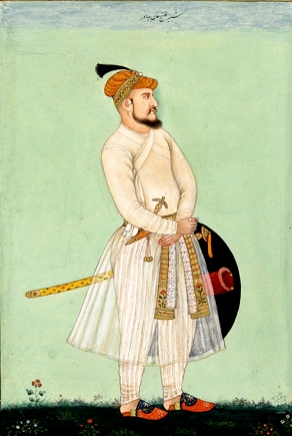
Khawaja Abid Khan Siddiqi, or Nawab Khawaja Abid Siddiqi, better known as Kilich Khan, was a Nawab and military general under Mughal Emperor Aurangzeb. He was a loyal general of the Mughal Empire. He was the father of the Mughal general Ghazi ud-Din Khan Feroze Jung I and the grandfather of Mir Qamar-ud-din Siddiqi, Asaf Jah I. Kilich Khan were claimed to be descendant of Abu Bakr, first Rashidun caliph.

Mir Shihab-ud-Din Siddiqi, known by his title Ghaziuddin Khan, was a leading military general and noble of Central Asian origin in the Mughal Empire. He was a favoured member of emperor Aurangzeb's court, and the father of Chin Qilich Khan, founder of Hyderabad State. Under Aurangzeb, he distinguished himself in key battles over the Deccan, and held the governorship of Berar Subah. He briefly served as the governor of Mughal Gujarat during the reign of Aurangzeb's successor Bahadur Shah, and died in office. He is buried in a madrasa complex he founded during his lifetime, known as Madrasa Ghaziuddin Khan, which is located in Old Delhi.

The siege of Golconda was a siege of Golconda Fort between the Qutb Shahi dynasty and the Mughal Emperor Aurangzeb, occurring in January 1687, lasting 8 months. The fort was home of the Kollur Mine. The Golconda Fort was considered to be an impregnable fort on the Indian subcontinent. At the end of the siege, Aurangzeb and the Mughals entered Golconda victorious.
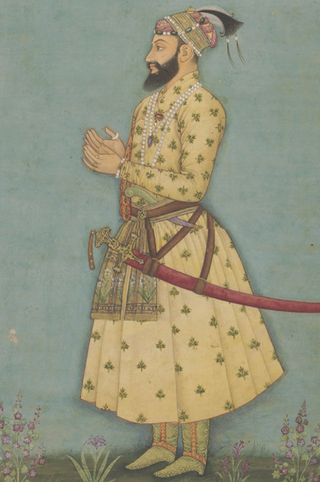
Mirza Muhammad Sultan was the eldest son of Mughal emperor Aurangzeb and his second wife Nawab Bai. His younger brother Muazzam later became Emperor as Bahadur Shah I in 1707.
The Battle of Jajau was fought between the two Mughal princes and brothers Bahadur Shah I and Muhammad Azam Shah on 20 June 1707. In 1707, their father Aurangzeb died without having declared a successor; instead leaving a will in which he instructed his sons to divide the empire between themselves. Their failure to reach a satisfactory agreement led to a military conflict. After Azam Shah and his three sons were killed in the Battle of Jajau, Bahadur Shah I was crowned as the Mughal emperor on 19 June 1707 at the age of 63.
The Mughal war of succession (1707–1709) or the Mughal Civil War was a period of political disorder and armed conflict over succession in the Mughal Empire following the death of the sixth Mughal emperor Aurangzeb in March 1707.
Mubariz Khan was the Mughal governor of Gujarat and Hyderabad Subah. He was the governor of Golconda from 1713 to 1724 until he was killed during the Battle of Shakar Kheda where he fought against Nizam-ul-Mulk, Asaf Jah I. His is known to have ruled Golconda with a free hand and brought it under stable rule from constant Maratha Raids to extract Chauth. He is generally described as a proto-dynastic figure by John F. Richards.

The Rajput rebellion began in 1708, due to the harsh treatment of the Rajput Rajas by the Mughal emperor. It erupted into a two-year rebellion that forced the Mughal emperor to sue for peace, give them gifts, and restore the Rajput holdings which had been annexed by the previous Mughal emperor Aurangzeb.

Asad Khan, born Muhammad Ibrahim, was a high-ranking noble of the Mughal Empire during the reigns of Aurangzeb and Bahadur Shah. He is known for his tenure as the wazir of emperor Aurangzeb in the period 1676–1707, and was an important player in Mughal court politics.
Hyderabad Subah, also known as Golconda Subah, was a province of the Mughal Empire encompassing the eastern Deccan region of the Indian subcontinent. It was created in 1687, during the reign of Mughal emperor Aurangzeb, by the annexation of the Golconda Sultanate. It later began to secede in the 18th century as the Mughal Empire declined and became fully independent as part of the Nizam-administered Deccan.
References
- 1 2 3 4 5 6 7 Richards, J. F. (1976). "The Imperial Crisis in the Deccan". The Journal of Asian Studies. 35 (2): 250–252. doi:10.2307/2053981. ISSN 0021-9118.
- 1 2 Richards 1975, p. 78-79.
- ↑ Richards, J. F. (1976). "The Imperial Crisis in the Deccan". The Journal of Asian Studies. 35 (2): 244. doi:10.2307/2053981. ISSN 0021-9118.
- 1 2 3 Irvine, William (1971). Later Mughals. Atlantic Publishers and Distributors. pp. 52–54 & 58–59.
- 1 2 Yazdani, Ghulam (1995). Bidar: its history and monuments (1. Indian ed.). Delhi: Motilal Banarsidass Publ. pp. 16 & 202. ISBN 978-81-208-1071-6.
- ↑ Richards 1975, p. 79.
- ↑ Richards 1975, p. 111-113.
- ↑ Richards 1975, p. 78, 216.
- ↑ Eaton, Richard Maxwell (2005), A social history of the Deccan, 1300-1761: eight Indian lives, Cambridge, UK: Cambridge University Press, pp. 162–163, ISBN 0-521-25484-1, OCLC 58431679
- ↑ Richards 1975, p. 224.
- 1 2 Richards 1975, p. 229-231.
- ↑ Richards 1975, p. 237.
- 1 2 3 4 Richards 1975, p. 236-243.
- ↑ Green, Nile (January 2004). "Auspicious Foundations: The Patronage of Sufi Institutions in the Late Mughal and Early Asaf Jah Deccan". South Asian Studies. 20 (1): 78. doi:10.1080/02666030.2004.9628637. ISSN 0266-6030.
- ↑ Khalidi, Omar (2009). A Guide to Architecture in Hyderabad, Deccan, India. Aga Khan Program for Islamic Architecture & MIT Libraries. p. 54.
- ↑ Bilgrami, Syed Ali Asgar. Landmarks of the Deccan. Asian Educational Services. pp. 96–98. ISBN 8120605438.